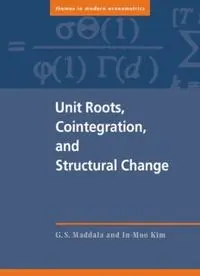
Unit Roots, Cointegration, and Structural Change (Themes in Modern Econometrics) PDF
Preview Unit Roots, Cointegration, and Structural Change (Themes in Modern Econometrics)
Unit Roots, Cointegration, and Structural Change Time series analysis has undergone many changes in recent years with the advent of unit roots and cointegration. Maddala and Kim present a comprehensive review of these important developments and examine structural change. The volume provides an analysis of unit root tests, problems with unit root testing, estimation of cointegration systems, cointegration tests, and econometric estimation with integrated regressors. The authors also present the Bayesian approach to these problems and bootstrap methods for small-sample inference. The chapters on structural change discuss the problems of unit root tests and cointegration under structural change, outliers and robust methods, the Markov switching model, and Harvey's structural time series model. Unit Roots, Cointegration, and Structural Change is a major contribution to Themes in Modern Econometrics, of interest both to specialists and graduate and upper-undergraduate students. G. S. MADDALA is University Eminent Scholar at the Ohio State University and one of the most distinguished econometricians writing today. His many acclaimed publications include Limited Dependent and Qualitative Variables in Econometrics (Cambridge, 1983) and Econometrics (McGraw-Hill, 1977) and Introduction to Econometrics (MacMillan, 1988, 1992). IN-MOO KIM is Professor of Economics at Sung Kyun Kwan University, Seoul, Korea. UNIT ROOTS COINTEGRATION AND STRUCTURAL CHANGE G. S. Maddala The Ohio State University In-Moo Kim Sung Kyun Kwan University CAMBRIDGE UNIVERSITY PRESS CAMBRIDGE UNIVERSITY PRESS Cambridge, New York, Melbourne, Madrid, Cape Town, Singapore, Sao Paulo Cambridge University Press The Edinburgh Building, Cambridge CB2 8RU, UK Published in the United States of America by Cambridge University Press, New York www.cambridge.org Information on this title: www.cambridge.org/9780521582575 © Cambridge University Press 1998 This publication is in copyright. Subject to statutory exception and to the provisions of relevant collective licensing agreements, no reproduction of any part may take place without the written permission of Cambridge University Press. First published 1998 Sixth printing 2004 A catalogue record for this publication is available from the British Library ISBN 978-0-521-58257-5 hardback ISBN 978-0-521-58782-2 paperback Transferred to digital printing 2007 To my parents G. S. Maddala To Jong Han, Jung Youn, and So Youn In-Moo Kim Contents Figures page xii Tables xi Preface xvi Part I Introduction and basic concepts 1 1 Introduction 3 References 6 2 Basic concepts 8 2.1 Stochastic proceses 8 2.2 Some commonly used stationary models 1 2.3 Box-Jenkins methods 17 2.4 Integrated variables and cointegration 20 2.5 Spurious regresion 28 2.6 Deterministic trend and stochastic trend 29 2.7 Detrending methods 32 2.8 VAR, ECM, and ADL 34 2.9 Unit rot tests 37 2.10 Cointegration tests and ECM 39 2.1 Sumary 41 References 42 Part I Unit rots and cointegration 45 3 Unit rots 47 3.1 Introduction 47 3.2 Unit rots and Wiener proceses 49 3.3 Unit root tests without a deterministic trend 60 3.4 DF test with a linear deterministic trend 65 vn viii Contents 3.5 Specification of deterministic trends 72 3.6 Unit root tests for a wide clas of erors 74 3.7 Sargan-Bhargava and Bhargava tests 82 3.8 Variance ratio tests 86 3.9 Tests for TSP versus DSP 87 3.10 Forecasting from TS versus DS models 89 3.1 Summary and conclusions 92 References 92 4 Isues in unit rot testing 98 4.1 Introduction 98 4.2 Size distortion and low power of unit root tests 100 4.3 Solutions to the problems of size and power 103 4.4 Problem of overdiferencing: MA roots 116 4.5 Tests with stationarity as nul 120 4.6 Confirmatory analysis 126 4.7 Frequency of observations and power of unit root tests 129 4.8 Other types of nonstationarity 131 4.9 Panel data unit root tests 133 4.10 Uncertain unit roots and the pre-testing problem 139 4.11 Other unit root tests 140 4.12 Median-unbiased estimation 141 4.13 Summary and conclusions 145 References 146 5 Estimation of cointegrated systems 155 5.1 Introduction 15 5.2 A general CI system 15 5.3 A two-variable model: Engle-Granger methods 156 5.4 A triangular system 160 5.5 System estimation methods 165 5.6 The identification problem 173 5.7 Finite sample evidence 175 5.8 Forecasting in cointegrated systems 184 5.9 Miscelaneous other problems 187 5.10 Summary and conclusions 191 References 191 6 Tests for cointegration 198 6.1 Introduction 198 6.2 Single equation methods: residual-based tests 198 Contents ix 6.3 Single equation methods: ECM tests 203 6.4 Tests with cointegration as nul 205 6.5 Multiple equation methods 211 6.6 Cointegration tests based on LCCA 222 6.7 Other tests for cointegration 226 6.8 Miscelaneous other problems 228 6.9 Of what use are cointegration tests? 233 6.10 Conclusions 241 References 242 7 Econometric modeling with integrated regressors 249 7.1 1(1) regressors not cointegrated 249 7.2 1(1) regresors cointegrated 250 7.3 Unbalanced equations 251 7.4 Lagged dependent variables: the ARDL model 252 7.5 Uncertain unit roots 254 7.6 Uncertain unit roots and cointegration 256 7.7 Summary and conclusions 258 References 258 Part I Extensions of the basic model 261 8 The Bayesian analysis of stochastic trends 263 8.1 Introduction to Bayesian inference 264 8.2 The posterior distribution of an autoregressive parameter 266 8.3 Bayesian inference on the Nelson-Plosser data 268 8.4 The debate on the appropriate prior 271 8.5 Classical tests versus Bayesian tests 277 8.6 Priors and time units of measurement 277 8.7 On testing point nul hypotheses 278 8.8 Further comments on prior distributions 284 8.9 Bayesian inference on cointegrated systems 287 8.10 Bayesian long-run prediction 290 8.1 Conclusion 291 References 292 9 Fractional unit roots and fractional cointegration 296 9.1 Some definitions 296 9.2 Unit root tests against fractional alternatives 298 9.3 Estimation of ARFIMA models 300 9.4 Estimation of fractionally cointegrated models 302
